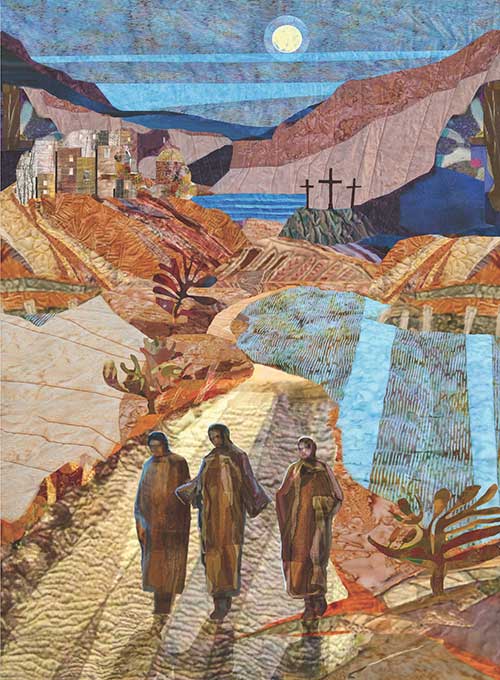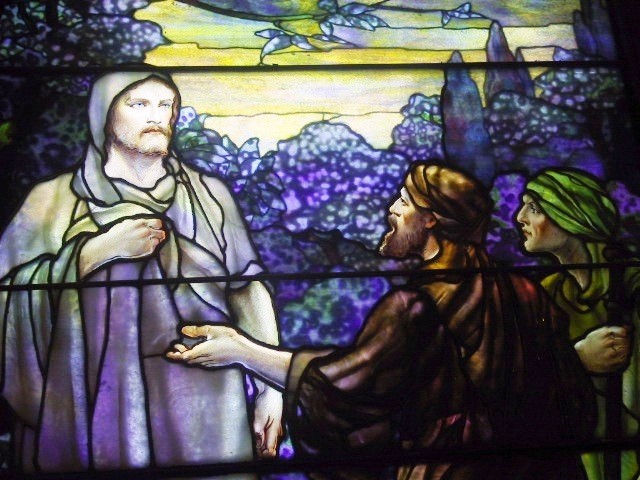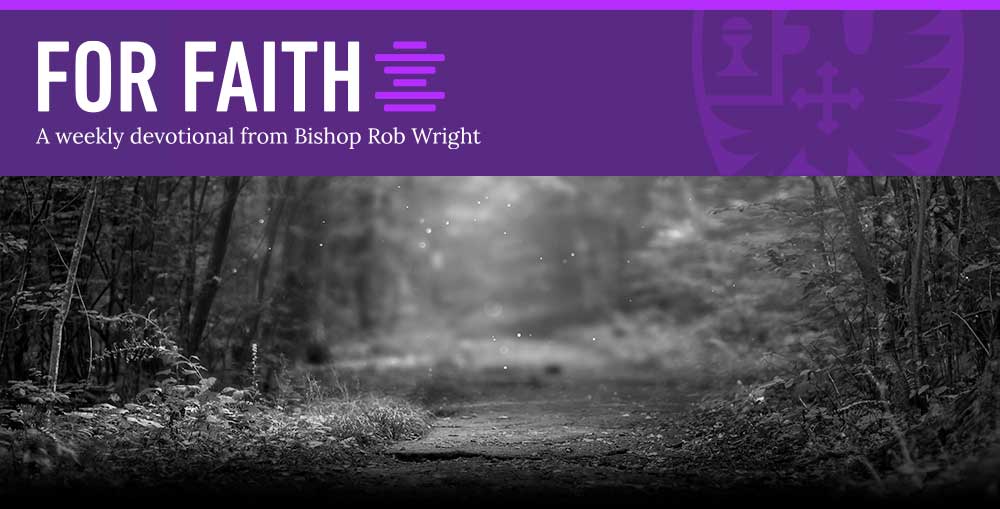Emmaus
Breaking Bread: SALT’S Lectionary Commentary for Easter 3

“Road to Emmaus” – Michael Torevell
Big Picture :
1) This is the third of the seven weeks of Eastertide, and the last of three stories of the risen Jesus appearing to his followers. The next four weeks (or three weeks, if Jesus’ Ascension is celebrated on the fourth) will explore Jesus’ teachings about faith and intimacy with God, all drawing on the Gospel of John.
2) As Luke tells it, this is the first time the risen Jesus steps onto the stage. In the passage just before this one, a group of women find Jesus’ tomb empty, and return to tell the male disciples that two angelic figures have proclaimed that he is alive — but the male disciples dismiss this as nonsense (though Peter, at least, goes to the tomb to see for himself). And now, in this week’s story, Jesus appears.
3) But not to Peter. Nor to Mary Magdalene. Nor to any of the others we’ve come to know over the course of the story. Moreover, Jesus doesn’t appear at the tomb, or at the Temple, or on the Mount of Olives, or at Herod’s palace or Pilate’s headquarters or the house of the high priest. Jesus’ post-crucifixion, alive-and-in-person appearance is, one would think, the highpoint of the story, the climax of the drama, the promised “rising again on the third day” — and so we would expect it to happen in some central, important place, to some central, important people in the narrative. But we’d be wrong. Where does Jesus appear? On a dusty road a couple of hours’ walk outside of Jerusalem, on the way to some now-forgotten village (archeologists today don’t know where “Emmaus” was located). And to whom? Two followers of Jesus — one named “Cleopas” and the other left anonymous — who haven’t even been mentioned yet in the story.
4) Come to think of it, this might remind us of where we began: the grand announcement of the Messiah’s birth is delivered to a few anonymous shepherds in the middle of nowhere (Luke 2:8-20). For Luke, the good news of the Gospel comes first of all not to insiders, but to ordinary folk in overlooked places. Just as he did when he was born, when Jesus rises and returns, he arrives from the outside in.
Scripture:
1) It’s Easter afternoon. In this story, the first surprise is that Jesus appears not in Jerusalem, but on a minor road to an obscure village. The second surprise is that he appears not to Peter, James, Mary, or Joanna, but rather to two minor characters in the story. But the third is the greatest surprise of all: though these two followers of Jesus originally staked their lives on the idea that he was the Messiah, “the one to redeem Israel” (literally “the one to set Israel free”); and though they’re heartbroken to have those hopes dashed; and though they’ve spent many months, perhaps years, walking with Jesus and listening to him along roads just like this one — still, they don’t recognize him (Luke 24:21). He’s right there, talking with them, walking beside them — and they don’t realize it’s him.
2) Why not? One possibility is that their eyes are veiled with tears; they’re overcome with sorrow about having seen their friend and teacher die, as well as disappointment that he turned out to be someone different than they’d hoped for. Perhaps their sadness and anxiety have turned them inward, away from the world, in oblivious self-absorption. They’ve lowered the window shades, we might say, from within their house of sorrow. Jesus is right there, standing outside — but they’re not looking.
3) Another possibility is that somehow Jesus is different, that resurrection doesn’t mean mere “resuscitation,” that the risen Jesus is in some way transformed. The two disciples lay eyes on him, hear his voice, even hear him teach — to no avail. From this point of view, the story suggests that the risen Jesus looks different, sounds different, even teaches in a different way. Cleopas calls him a “resident foreigner”: the word translated as “stranger” here is paroikeis, literally “reside as a foreigner” — suggesting that not only his apparent ignorance about current events (What are you talking about?) but also his overall appearance or style of speech comes across as an unfamiliar outsider (Luke 24:18).
Visual Lectionary Vanderbilt – Easter 3, April 23, 2023
Click here to view in a new window.
Road to Emmaus in Stained Glass
Note- The “Road to Emmaus” here refers to a stained glass window at St. George’s Episcopal, Fredericksburg based on the Luke Gospel reading

Inscription: None
Maker/Date: Tiffany Studios, New York, 1912
Description – The story of this window is from Luke, chapter 24, verses 13 to 35.
Jesus Christ rises from the dead (before dawn) and makes five appearances on the day of His rising. This window represents #3 below:
1 To Mary Magdalene [given a message to the disciples]
2 To the other women who come to the tomb [intending to complete the burial preparation of His body]
3. To two disciples on the Road to Emmaus
4. To Simon Peter [nowhere recorded, but alluded to in Luke 24:33 and 1 Corinthians 1:5]
5. To the astonished disciples [Thomas is absent]
There are a number of unknowns – Emmaus cannot be found on any map though only 7 miles from Jerusalem. The concept of a road was a common metaphor at the time – The early Christians were called “people of the way.” The Road to Emmaus may have been an actual physical road or only a spiritual road
In the image, Cleopas and an unnamed companion encounter the risen Christ on the road to Emmaus about seven miles from Jerusalem
There are two companions – we don’t know the name of one and Cleopas the other one is only mentioned in the Good Friday reading of the Gospel of John. One of the key parts of the story is that the two companions were not apostles, not part of the inner circle. Just everyday people. In all of the other resurrection experiences, Jesus appears to the group around Jesus.
Two unknowns going to an unknown place. The reason they are going is not disclosed. Are they ending Passover and simply returning after the event in a normal fashion or they are fleeing a desperate situation in Jerusalem?
The look of incredulity and awe on the faces of the men stands in contrast to the dignity and still expression of Christ.
The men are shocked that anyone could have been in Jerusalem and not known of the events that have happened there.
“Abide with us,” they ask the unrecognized stranger, “for it is toward evening, and the day is far spent.” ]
It was not until they offered Him hospitality and He blessed and broke the bread that they recognized Him. He soon disappeared.
They got up and returned at once to Jerusalem. There they found the Eleven and those with them, assembled together and saying, “It is true! The Lord has risen and has appeared to Simon.”
Luke 24 is often seen as a model of the journey that Jesus makes with us today. He opens our eyes, points us to the Word, and reveals Himself along life’s walk as the resurrected Savior and Lord. One of the things the story teaches is that Jesus cares for your hopes and your dreams.
Seven Miles
From Bishop Rob Wright, Diocese of Atlanta. Road to Emmaus Luke 24:13-35

“The news of the Resurrection of Jesus took some time to reach everyone. Some of his friends were so discouraged by his arrest and Crucifixion that they decided to head to a village called Emmaus, seven miles outside of Jerusalem. We understand why they wanted to run away. We understand the impulse to run away from the jagged edges of reality.
“What grabs me about this story is that Jesus was running towards them as they were running away! As Jesus walks and talks with them, they tell him the sad story. The partial story. (They hadn’t recognized him yet.).But, by the time they reach Emmaus, they see him. They get understanding. The good news of his life penetrates their sadness.
“You may not be up to walking seven miles today but go for a walk soon. Tell Jesus all your sorrow and your fears on the walk. And then just listen, open your ears, eyes and heart to him anew.”
Lectionary, Easter 3, April 23, 2023
I.Theme – Now after the Resurrection what must we do ?

"Road to Emmaus" , Tiffany (1912)
The lectionary readings are here or individually:
First Lesson – Acts 2:14a,36-41
Psalm – Psalm 116:1-3, 10-17 Page 759, BCP
Epistle –1 Peter 1:17-23
Gospel – Luke 24:13-35
The answer to what we must do after the Resurrection comes in the various readings to this week’s lectionary.
In Acts, Peter declares God had made the risen Jesus both Lord and Christ. The people respond, "What must we do?" "Repent and be baptized."
The Epistle answers "live as the baptized" in reverent fear of God, and with deep affection for one another from the heart.
The writer of the Psalms package was in a time illness, near death.Tthe answer is to love and praise God since God saved him from this affliction. He will worship the Lord, and praise the Lord in the worshipping community in the temple.
The Gospel reading on the Road to Emmaus provides the fullest explanation.
The emphasis is on evangelism and mission. Two companions are on the road to Emmaus, some 7 miles from Jerusalem. Jesus meets up with them but they didn’t recognize him. He taught them the importance of sustaining their faith through scriptures. It wasn’t until they stopped for the night for a meal that they recognized Christ in the breaking of the bread. After the revelation of Jesus in the scriptures and in the Eucharist, the two individuals went back and shared their faith experience with the community, the Body of Christ in Jerusalem.
What would sustain the community of faith was the Word of Jesus, friends involved in community worship and participating with the sacraments. They had to live out and experience Jesus through revelation. The followers needed to open their minds and hearts to new possibilities as they fulfilled the mandate to preach repentance and forgiveness everywhere in the name of Jesus. We need to expect Jesus outside our normal experience.
Sunday links, Easter 3, April 23, 2023

Easter lily on Easter 2
Coming up!
The Earth Day 2023 Theme is “Invest In Our Planet. What Will You Do?” We are focusing this year on plastics consumption. The Earth Day site has a plastics calculator
We are holding a “trashy contest.” Prizes will be given at the end of April at in the following categories for trash you pick up and throw away on walks- amount of trash, grossest piece of trash, smallest and large piece of trash. Bring your entry to church on Sunday, April 23.
Shred-it is scheduled for Wednesday, May 10. Time has not been arranged. Dispose of sensitive documents safely and securely, and free up needed space at home or work.
Emmaus in Song
This is a hymn based on Celtic musical sources and words by Marty Haugen who writes music for Lutheran Church
On the Road to Emmaus Words
